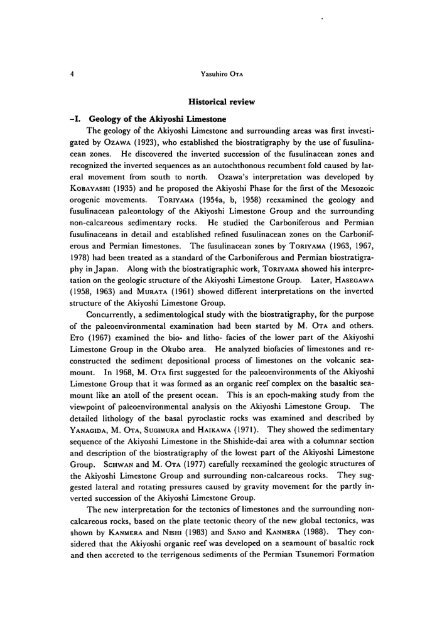Biostratigraphy of the Akiyoshi Limestone Group,
Biostratigraphy of the Akiyoshi Limestone Group,
Biostratigraphy of the Akiyoshi Limestone Group,
You also want an ePaper? Increase the reach of your titles
YUMPU automatically turns print PDFs into web optimized ePapers that Google loves.
Yasuhiro Ota<br />
Historical review<br />
-I. Geology <strong>of</strong> <strong>the</strong> <strong>Akiyoshi</strong> <strong>Limestone</strong><br />
The geology <strong>of</strong> <strong>the</strong> <strong>Akiyoshi</strong> <strong>Limestone</strong> and surrounding areas was first investi<br />
gated by Ozawa (1923), who established <strong>the</strong> biostratigraphy by <strong>the</strong> use <strong>of</strong> fusulina<br />
cean zones.<br />
He discovered <strong>the</strong> inverted succession <strong>of</strong> <strong>the</strong> fusulinacean zones and<br />
recognized <strong>the</strong> inverted sequences as an autochthonous recumbent fold caused by lat<br />
eral movement from south to north. Ozawa's interpretation was developed by<br />
Kobayashi (1935) and he proposed <strong>the</strong> <strong>Akiyoshi</strong> Phase for <strong>the</strong> first <strong>of</strong> <strong>the</strong> Mesozoic<br />
orogenic movements. Toriyama (1954a, b, 1958) reexamined <strong>the</strong> geology and<br />
fusulinacean paleontology <strong>of</strong> <strong>the</strong> <strong>Akiyoshi</strong> <strong>Limestone</strong> <strong>Group</strong> and <strong>the</strong> surrounding<br />
non-calcareous sedimentary rocks. He studied <strong>the</strong> Carboniferous and Permian<br />
fusulinaceans in detail and established refined fusulinacean zones on <strong>the</strong> Carbonif<br />
erous and Permian limestones. The fusulinacean zones by Toriyama (1963, 1967,<br />
1978) had been treated as a standard <strong>of</strong> <strong>the</strong> Carboniferous and Permian biostratigra<br />
phy in Japan. Along with <strong>the</strong> biostratigraphic work, Toriyama showed his interpre<br />
tation on <strong>the</strong> geologic structure <strong>of</strong> <strong>the</strong> <strong>Akiyoshi</strong> <strong>Limestone</strong> <strong>Group</strong>. Later, Hasegawa<br />
(1958, 1963) and Murata (1961) showed different interpretations on <strong>the</strong> inverted<br />
structure <strong>of</strong> <strong>the</strong> <strong>Akiyoshi</strong> <strong>Limestone</strong> <strong>Group</strong>.<br />
Concurrently, a sedimentological study with <strong>the</strong> biostratigraphy, for <strong>the</strong> purpose<br />
<strong>of</strong> <strong>the</strong> paleoenvironmental examination had been started by M. Ota and o<strong>the</strong>rs.<br />
Eto (1967) examined <strong>the</strong> bio- and litho- facies <strong>of</strong> <strong>the</strong> lower part <strong>of</strong> <strong>the</strong> <strong>Akiyoshi</strong><br />
<strong>Limestone</strong> <strong>Group</strong> in <strong>the</strong> Okubo area. He analyzed bi<strong>of</strong>acies <strong>of</strong> limestones and re<br />
constructed <strong>the</strong> sediment depositional process <strong>of</strong> limestones on <strong>the</strong> volcanic seamount.<br />
In 1968, M. Ota first suggested for <strong>the</strong> paleoenvironments <strong>of</strong> <strong>the</strong> <strong>Akiyoshi</strong><br />
<strong>Limestone</strong> <strong>Group</strong> that it was formed as an organic reef complex on <strong>the</strong> basaltic seamount<br />
like an atoll <strong>of</strong> <strong>the</strong> present ocean. This is an epoch-making study from <strong>the</strong><br />
viewpoint <strong>of</strong> paleoenvironmental analysis on <strong>the</strong> <strong>Akiyoshi</strong> <strong>Limestone</strong> <strong>Group</strong>. The<br />
detailed lithology <strong>of</strong> <strong>the</strong> basal pyroclastic rocks was examined and described by<br />
Yanagida, M. Ota, Sugimura and Haikawa (1971). They showed <strong>the</strong> sedimentary<br />
sequence <strong>of</strong> <strong>the</strong> <strong>Akiyoshi</strong> <strong>Limestone</strong> in <strong>the</strong> Shishide-dai area with a columnar section<br />
and description <strong>of</strong> <strong>the</strong> biostratigraphy <strong>of</strong> <strong>the</strong> lowest part <strong>of</strong> <strong>the</strong> <strong>Akiyoshi</strong> <strong>Limestone</strong><br />
<strong>Group</strong>. Schwan and M. Ota (1977) carefully reexamined <strong>the</strong> geologic structures <strong>of</strong><br />
<strong>the</strong> <strong>Akiyoshi</strong> <strong>Limestone</strong> <strong>Group</strong> and surrounding non-calcareous rocks. They sug<br />
gested lateral and rotating pressures caused by gravity movement for <strong>the</strong> partly in<br />
verted succession <strong>of</strong> <strong>the</strong> <strong>Akiyoshi</strong> <strong>Limestone</strong> <strong>Group</strong>.<br />
The new interpretation for <strong>the</strong> tectonics <strong>of</strong> limestones and <strong>the</strong> surrounding noncalcareous<br />
rocks, based on <strong>the</strong> plate tectonic <strong>the</strong>ory <strong>of</strong> <strong>the</strong> new global tectonics, was<br />
shown by Kanmera and Nishi (1983) and Sano and Kanmera (1988). They con<br />
sidered that <strong>the</strong> <strong>Akiyoshi</strong> organic reef was developed on a seamount <strong>of</strong> basaltic rock<br />
and <strong>the</strong>n accreted to <strong>the</strong> terrigenous sediments <strong>of</strong> <strong>the</strong> Permian Tsunemori Formation
















